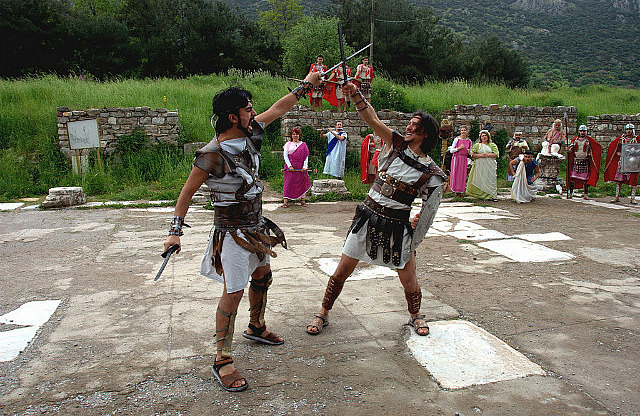The region around Izmir (ancient Smyrna) and Ephesus was a major center of ancient Greek civilization, whose importance continued under Roman and Byzantine rule, when Greek continued to be the spoken language. Since then the area has been supplanted with Muslim Turkish language and culture.
~1100 BC - Ancient Greek poet Homer born near Smyrna (Izmir).
~1000 BC - Ephesus founded.
to 545 BC - Greek rule by local city states.
to 340 BC - Persian rule from Persepolis, Iran.
to 133 BC - Greek rule from Pergamum, Turkey. 140 BC - Temple of Artemis in Ephesus included in the Seven Wonders of the Ancient World by Greek traveler Antipater.
to 395 AD - Roman rule from Rome, Italy. Ephesus is capital of Asia province.
to 1304 - Christian Byzantine/Greek rule from Constantinople (Istanbul). ~700 AD - Ephesus gradually abandoned.
to 1919 - Muslim Turkish rule from Istanbul.
to 1922 - Izmir occupied by Greece, ruled from Athens.
1922 - modern Turkey established, with capital at Ankara.
Our family group took the group tour to Ephesus from Izmir, Turkey. I took a similar tour the last time I was here in 2004 and was very impressed. Once we got off the ship in Izmir, there were dancers in traditional clothing at the port performing a welcome dance, girls in pretty head scarves distributed evil-eye souvenirs (to ward off evil spirits) to each of us. When we got on the tour bus, we got a packet of gifts on each seat, including a clay tablet ticket that ancient Romans used to enter the theatre, Turkish evil-eye pendant, map of Turkey, and bottled water! We were impressed by these gestures of hospitality. The weather was drizzly again as our bus sped onto the expressway toward Ephesus, going past rolling hills with lush vegetation, orchards of peaches and figs.
Before arriving in Ephesus we stopped at a rest stop with a souvenir shop, where we were impressed by the beautiful exotic things offered at good prices. Our tour guide is a jovial older gentleman who paid special attention to Novlett, Neil's beautiful sister. He told her that Turkish people are curious about black people since they don't have any. He said not to be bothered by local people trying to approach you, touch you, etc.
When we got to the ruins of Ephesus it was a zoo of tour groups. Our tour guide didn't do a good job of showing us the sights, instead he occupied a lot of the time with talks that seemed less relevant. My mom, who had been there before with me, found the luxurious ancient Roman bathroom ruins in a side alley. She tried to get our group to go see it, but she just said "bathroom" to which others responded that they didn't need to go to the bathroom!
Still, everyone was impressed by the grandeur of the ruins, the multitude of marble sculptures, although some were not restored gracefully. Ephesus was the capital of the Roman province of Asia, and the 4th largest city in the empire after Rome, Alexandria, and Antioch. The restored Celsus Library was a stunning sight, as was the hillside theatre seating 24,000. We explored the steps of the theatre and its narrow entrances where clay tablet tickets would have been collected. In the open field next to the theatre we witnessed a performance of ancient Roman gladiator battle scene, where many actors and actresses in colorful period clothing played characters such as juggler, stone mason, Roman senator and soldiers. It was raining but not too heavily, the performance went on in the rain but it was entertaining nonetheless.
Finally we headed out of the lower gate of the historic preservation park and into a bazaar. There were exotic craft items hanging on the olive trees, and young, handsome hawkers milling about. It started raining more heavily, forcing us to retire to the bus.
At the end of the tour our tour guide took us to a carpet showroom compound where we watched a demonstration of how silk worms are raised, how silk is made from their pupae, and how carpets are woven using a traditional loom. In the carpet showroom we were served either Turkish tea, beer, wine, or raki (a strong liquor like the ouzo), while a salesman showed off their amazingly beautiful but very very expensive carpets. He was very pleasant and didn't use pressure tactics to make a sale. As we exited the compound we were led to walk through a series of stores stocked with beautiful wares from jewelry, leather goods, glass/ceramics, and textiles. It was a good opportunity to get some souvenirs. Although the place was a tourist trap it was also a fascinating culture experience for many of us. This was a nice end to a more relaxed day of touring compared to our previous few tours. Before getting on the ship, I found internet again in the port facilities. Here I found out the Turkish keyboard has two different letter i's.

